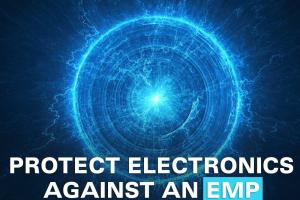Ultimate Guide: How to Protect Electronics from an Electromagnetic Pulse

-
Quick Links:
- Understanding Electromagnetic Pulse (EMP)
- Types of Electromagnetic Pulses
- The Impact of EMP on Electronics
- Protective Measures Against EMP
- Building a Faraday Cage
- Using EMP Shielding Products
- Case Studies and Expert Insights
- Conclusion
- FAQs
Understanding Electromagnetic Pulse (EMP)
An Electromagnetic Pulse (EMP) is a burst of electromagnetic radiation that can disrupt or damage electronic equipment and electrical systems. EMPs can be caused by various sources, including nuclear explosions, solar flares, and certain types of non-nuclear weapons. Understanding the nature of EMPs is crucial for anyone looking to protect their electronic devices.
Types of Electromagnetic Pulses
There are three primary types of EMPs:
- Nuclear EMP (NEMP): Generated by nuclear explosions, typically at high altitudes, causing widespread damage.
- Non-Nuclear EMP (NNEMP): Resulting from conventional weapons or specialized EMP devices.
- Solar EMP: Caused by solar flares that release charged particles, interacting with the Earth's magnetic field.
The Impact of EMP on Electronics
Electronics are susceptible to EMPs because they rely on delicate circuits and microprocessors. The impact can range from temporary disruption to permanent damage. Devices such as computers, smartphones, and home appliances are particularly vulnerable.
According to a report from the EMP Commission, a single large-scale EMP event could potentially incapacitate critical infrastructures, including power grids and communication systems.
Protective Measures Against EMP
To safeguard your electronics from EMP damage, consider the following protective measures:
- Surge Protectors: Invest in high-quality surge protectors to help minimize the impact of voltage spikes.
- Faraday Cages: Utilize Faraday cages to create a shield against EMPs.
- EMP-Resistant Devices: Look for electronics specifically designed to withstand EMPs.
- Backup Systems: Maintain backup systems for critical electronics to ensure redundancy.
Building a Faraday Cage
A Faraday cage is an enclosure made from conductive materials that blocks electromagnetic fields. Here’s how to build one:
- Materials Needed: Copper mesh, aluminum foil, or conductive paint.
- Frame Construction: Create a frame using wood or metal that will hold your conductive material.
- Covering the Frame: Wrap the frame in the conductive material, ensuring no gaps.
- Grounding: Ground the cage to dissipate any electromagnetic energy safely.
Place your sensitive electronics inside the cage to protect them from EMPs.
Using EMP Shielding Products
Various commercial products are designed for EMP protection, including:
- EMP Shielding Bags: These bags are made from conductive materials and can protect individual devices.
- Shielded Rooms: For larger setups, consider creating a shielded room using specialized materials.
- EMP Filters: Install EMP filters on power lines to prevent surges from entering your electrical system.
Case Studies and Expert Insights
In recent years, various experts have examined the impact of EMPs. A case study from the Department of Defense outlines how military installations prepare for EMP threats. They emphasize the importance of redundancy and quick recovery strategies to mitigate risks.
In another study by the NASA, researchers explored the effects of solar EMPs on satellite systems, leading to improved shielding designs.
Conclusion
Protecting electronics from electromagnetic pulses is essential in today's technology-driven world. By understanding the types of EMPs and implementing effective protective measures, you can safeguard your devices against potential catastrophic failures.
FAQs
1. What is an EMP?
An EMP is a burst of electromagnetic energy that can disrupt or damage electronic equipment.
2. How does a nuclear EMP differ from a solar EMP?
A nuclear EMP results from a nuclear explosion, while a solar EMP is caused by solar flares interacting with Earth's magnetic field.
3. Can surge protectors prevent EMP damage?
While surge protectors can help minimize damage from power surges, they are not guaranteed to protect against EMPs.
4. What materials are best for building a Faraday cage?
Copper mesh and aluminum foil are popular choices for constructing effective Faraday cages.
5. Are there commercial products for EMP protection?
Yes, there are EMP shielding bags, filters, and even shielded rooms available on the market.
6. How can I test the effectiveness of my Faraday cage?
Place a battery-powered radio inside, close it up, and see if the radio receives any signals. If it doesn't, your cage is working well.
7. What are the signs of EMP damage to electronics?
Common signs include devices not powering on, erratic behavior, or complete failure of electronic systems.
8. Is EMP protection necessary for all households?
While not necessary for everyone, individuals in high-risk areas or those with critical electronic dependencies should consider it.
9. Can EMPs affect non-electronic systems?
Yes, EMPs can also disrupt systems like transportation and communication that rely on electronic components.
10. Where can I find more information on EMP protection?
For more detailed insights, consult resources from organizations like the EMP Council and the FEMA.
Random Reads